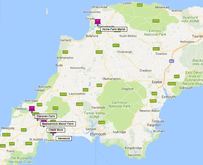What you can see at Treraven
Treraven Farm is part of the Camel SSSI & SAC. In addition to existing semi-ancient oak woodland alongside the Camel River, the Trust has planted a community forest of native broadleaved trees to which will provide a series of circular walks from the Camel Trail. There is also a public footpath running through the farm from Wadebridge to St Breock Downs, and 2 additional field walks have been dedicated at each end of this route. The Royal Horticultural Society’s collection of bamboo located at Treraven is looking very mature and greatly adds to the amenities on this site.
Treraven Farm contains a number of habitats, including:Upland oak woodland, locally referred to as western oak woodland. Treraven Wood is a good example of an ancient ‘upland’ oakwood and as such it is a Biodiversity Action Plan habitat. It contains ancient semi-natural woodland, and ancient replanted woodland, and partly falls into a County Wildlife Site. Typical trees that can be found include ash, sessile oak, beech and sycamore, along with the Wild Service tree and shrub layers including hazel, holly and hawthorn. Bluebells carpet the steeply sloping woods in late spring, with other flowers such as Wood Anemone and Ransoms. Other plants identified include: Hard Fern, Opposite-leaved Golden-saxifrage, Scaly Male-fern, Hart’s Tongue, Common Polypody, Soft Shield Fern, Great Woodrush, Common Cow-wheat, Wood Sedge, Sweet Woodruff, Sanicle, Bilberry, Wood Speedwell and Primrose. Amongst the mosses, lichens and fungi, the nationally rare moss Weissia multicapsularis has been recorded. A number of mammal species have been recorded within Treraven Woods, including the roe deer and stoat. There has been a recording in 1996 of the Dormouse, but hazelnuts with typical signs of dormouse knawing have not been found since. Dormouse nest boxes have recently been put-up at various points in Treraven’s old and new woodland and these will be closely monitored. Otters, found in this section of the River Camel, are likely to use the wood where it lies adjacent to the river. Salt water meadows: Treraven’s original water meadows, along the Camel Trail, are being restored as part of the creation of a much larger salt marsh system, one of the largest habitat restoration projects in Cornwall by The Environment Agency and Natural England. A series of pipes and a new creek system enables what was reclaimed agricultural land to once again become flooded with seawater at spring tides. This will improve the wildlife value of the Camel estuary for species such as otter, kingfisher, mullet, flounder, lapwing and curlew. Open mixed scrub with common gorse, spindle, blackthorn and hawthorn. Community Forest – planted by the Trust with the help of residents and local schools, and consisting of native broadleaved trees, with supporting walks and paths. Permanent pasture – the remainder of the land is permanent pasture, run on organic lines. |
Map and Guide |


